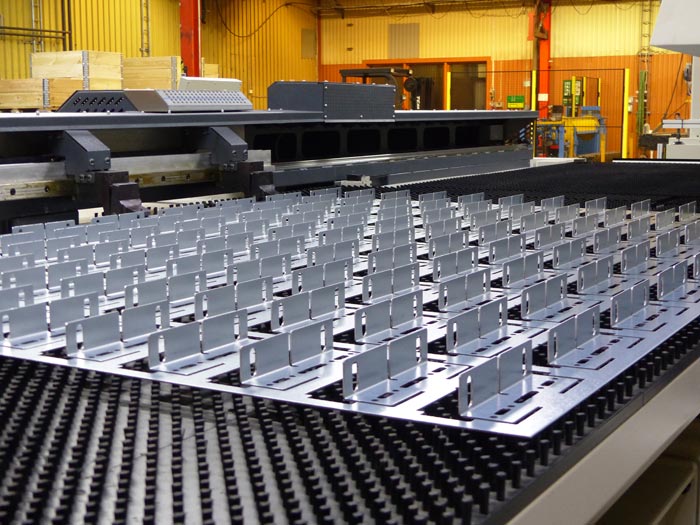ผู้ผลิตแผ่นโลหะต้องมองหาการประหยัดต้นทุนในทุกด้านของธุรกิจรวมถึงการลดการเกิดเศษจากการผลิตและการประหยัดพลังงาน
ขณะที่โรงงานผลิตชิ้นงานโลหะแผ่นพยายามค้นหาวิธีการใหม่ๆ ในการลดค่าใช้จ่าย เทคโนโลยีใหม่ที่เพิ่งเปิดตัวเมื่อไม่นานมานี้สามารถประหยัดต้นทุนได้ในรูปแบบที่ในอดีตไม่สามารถทำได้ นั่นคือการบริหารการลดการเกิดเศษและการประหยัดพลังงานอาจจะไม่มีคุณลักษณะพิเศษที่แสดงผลโดยตรงแบบที่อัตราการตอกต่อนาที [hits per minute (HPM)] หรือความลึกของแกน Y [deep throat depth] มี แต่ในการผลิตทุกวันนี้ กระทั่งเศษเล็กๆ น้อยๆ ที่เป็นของเหลือจากการผลิตล้วนมีประโยชน์ทั้งนั้น เครื่องเจาะรุ่นใหม่มีความทันสมัย รวดเร็ว ไว้วางใจได้ และส่วนใหญ่ทำงานโดยอัตโนมัติ อย่างไรก็ตาม มีบางอย่างที่อาจจะทำให้มันช้าลง เช่น เมื่อชิ้นส่วนติดอยู่ในเศษโครงเหล็ก ความเร็วของกระบวนการและความเชื่อมั่นจะได้รับผลกระทบในทางลบ นอกจากนี้การขนถ่ายเศษโครงเหล็กยังเป็นอีกหนึ่งขั้นตอนการทำงานที่จำเป็นต้องมีผู้ควบคุมเครื่องเพื่อทำการเคลื่อนย้ายสิ่งที่เหลืออยู่ไปยังภาชนะ หรือต้องมีระบบอัตโนมัติที่ต้องใช้ทั้งเวลาและการลงทุนเครื่องเจาะอัตโนมัติสมัยใหม่สามารถจัดเรียงและแยกชิ้นส่วนแต่ละชิ้นเพื่อการจัดเก็บและขนย้ายต่อไป ในบางระบบ ชิ้นงานที่ถูกเจาะสามารถยกออกได้ โดยใช้เครื่องมือคัดเลือก-จัดเรียงจะจับชิ้นส่วนเมื่อแผ่นโลหะชิ้นสุดท้ายถูกเคลื่อนย้าย จากนั้นชิ้นส่วนจะถูกยกออกจากผังด้วยเครื่องดูดที่ตั้งโปรแกรมได้
ทั้งนี้ด้วยกระบวนการทำงานที่กล่าวไว้ข้างต้นจะมีผลทำให้รอบเวลาของเครื่องจักรจะยาวขึ้น ซึ่งการใช้ระบบอัตโนมัติอาจจะลดรอบเวลาโดยรวมลงได้ ขึ้นอยู่กับรูปร่าง ขนาด และจำนวนของชิ้นส่วนบนแต่ละแผ่น นั่นคือชิ้นส่วนจะมาถึงการดำเนินการต่อไปเร็วขึ้น ซึ่งส่วนใหญ่จะเป็นอัตราที่สม่ำเสมอใช่ หากไม่มีระบบอัตโนมัติ
เครื่องกดเจาะจะสามารถผลิตชิ้นส่วนได้มากกว่าในช่วงเวลาที่กำหนด แต่บ่อยครั้งที่ชิ้นส่วนเหล่านั้นจะกองอยู่บนพื้นขณะที่ผู้ควบคุมเครื่องต้องใช้มือเขย่ามันออกจากผังเพื่อจัดเรียง (และการจัดเรียงก็มีแนวโน้มว่าจะผิดพลาด) เครื่องกดเจาะอาจจะผลิตชิ้นส่วนได้มากกว่า แต่มันอาจจะเพียงแค่ป้อนชิ้นส่วนไปยังจุดติดขัดของการเขย่าและการจัดเรียงก็เป็นได้ ยิ่งกว่านั้น ระบบอัตโนมัติยังลดโอกาสของความผิดพลาดในการจัดเรียง เช่น เมื่อผู้ดูแลวัสดุจัดกลุ่มชิ้นส่วนสองกลุ่มจากต่างชิ้นงานที่ดูคล้ายกันผิดพลาด ข้อผิดพลาดเหล่านี้อาจจะเพิ่มขึ้นหากเป็นการจัดผังแบบไดนามิคซึ่งชิ้นส่วนจากหลายๆ ชิ้นงานถูกจัดกลุ่มอยู่บนแผ่นเดียว

HACO –Q Series: เป็นมากกว่าเครื่องกดเจาะ
ด้วยหัวเจาะความเร็วสูงระบบไฮบริด (ไฟฟ้า-ไฮดรอลิค) ขนาด 22-30 ตัน แกน Y (throat) ขนาด 1615 มม. และแกนหมุนความเร็วสูงสำหรับเครื่องมือทั้งหมด Haco Q5 จึงเป็นเครื่องเจาะระบบหัวตอก CNC ที่สมบูรณ์แบบและยืดหยุ่นที่สุดในตลาด Haco Q-series จะเปลี่ยนโรงงานของคุณให้เป็นโรงงานที่มีความสามารถในการผลิตและมีความยืดหยุ่นสูงสุดด้วยเครื่องเจาะแผ่นโลหะ CNC
จากเครื่องกดเจาะแบบดั้งเดิมสู่เครื่องผลิตชิ้นส่วนหลายหน้าที่ ด้วยคุณลักษณะมากมายต่อไปนี้ การผลิตชิ้นส่วนจึงไม่จำเป็นต้องมีการดำเนินการลำดับที่สองซึ่งมีค่าใช้สูง
- การต๊าปโดยการใช้ด้ามและเม็ดมีดมาตรฐานตัวปรับที่เป็นสากลและราคาไม่แพงสามารถยึดต๊าปรีดเกลียวจาก M2 ถึง M10
- ข้อรัดเดี่ยวที่สามารถตั้งโปรแกรมอัตโนมัติเพื่อความแม่นยำมากขึ้น
- ประตูเอียงขนาดยักษ์ (750 มม. X 1500 มม.) พร้อมสายพานลำเลียง
- ความสามารถในการโค้งงอ 70 มม.
- เครื่องมือที่ทำดัชนีได้ 20 ชิ้น หรือเครื่องมืออเนกประสงค์ที่ทำดัชนีได้ 200 ชิ้นสามารถบรรจุไว้ในอุปกรณ์เปลี่ยนเครื่องมือแบบสองทิศทาง
- จังหวะการเจาะซึ่งปรับได้เพื่อประสิทธิผลและความปลอดภัยสูงสุด
- ระบบการขนถ่ายแผ่นโลหะด้วยการเลือกและจัดเรียงหรือด้วยระบบ Evac Train
- การใช้ประโยชน์จากเครื่องมือที่มีล้อ

TruMatic 1000 fiber จากก้าวเล็กๆ สู่ความยิ่งใหญ่
TruPunch 1000 (S19) รุ่นใหม่เป็นเครื่องพั้นซ์ชิ่งรุ่นสมรรถนะปานกลาง ราคาย่อมเยา เหมาะสำหรับผู้ประกอบการที่เพิ่งจะเริ่มต้นธุรกิจซึ่งยังไม่ต้องการกำลังการผลิตสูงมากนัก เครื่องจักรรุ่นนี้สามารถปรับเปลี่ยน และอัพเกรดให้เป็น TruMatic 1000 fiber เครื่องพั้นซ์ชิ่ง และเครื่องตัดเลเซอร์ในหนึ่งเดียว เพื่อรองรับการเติบโตของธุรกิจ ด้วย TruDisk solid-state laser ขนาด 3kW สามารถเชื่อมต่อกับเครื่อง TruPunch 1000 (S19)ได้ และสามารถเปลี่ยนการใช้งานจากเลเซอร์แบบ 2D มาเป็น เทคโนโลยีการพั้นซ์ชิ่งและการตัดด้วยเลเซอร์ได้ง่ายด้วยเงินทุนเพียงเล็กน้อย ในส่วนของผู้ใช้งานที่มี TruDisk solid-state laser อยู่แล้ว สามารถใช้งาน TruMatic 1000 fiber ร่วมกับ TruDisk ตัวเดิมโดยผ่านระบบเครือข่ายเลเซอร์ของทรุ้มพ์ฟได้
เครื่องพั้นซ์ชิ่งและเครื่องตัดเลเซอร์นี้ให้ประโยชน์แก่ผู้ใช้งานในแต่ละกระบวนการ ความเร็วในการตัดด้วยเลเซอร์ผสมผสานกับความสามารถในการเจาะ ตอกรู ขึ้นรูปของเครื่องพั้นซ์ชิ่ง จะช่วยลดปัญหาของการทำงาน 2 ขั้นตอน สิ่งที่สำคัญไปกว่านั้นคือ การสับเปลี่ยนโหมดการใช้งานระหว่างการตัดด้วยเลเซอร์และพั้นซ์ชิ่งเป็นไปอย่างมีประสิทธิภาพและไม่เกิดการแทรกแซงซึ่งกันและกัน












